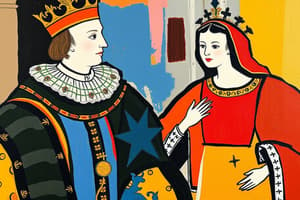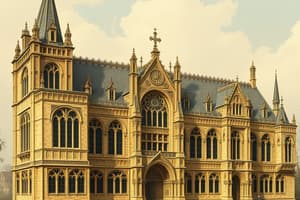Podcast
Questions and Answers
What was a significant challenge Northumberland faced while ruling on behalf of Edward VI?
What was a significant challenge Northumberland faced while ruling on behalf of Edward VI?
- He had complete control over the monarchy.
- He had the support of all the nobles.
- He was blamed for the failures of the government. (correct)
- He was popular among the people.
Why did Northumberland seek to disinherit Mary and Elizabeth?
Why did Northumberland seek to disinherit Mary and Elizabeth?
- He believed Mary would be a more favorable ruler.
- He wanted to ensure a Catholic succession.
- He wished to eliminate all royal heirs.
- He aimed to prevent the restoration of papal authority. (correct)
What was the main consequence of Edward VI's death in 1553?
What was the main consequence of Edward VI's death in 1553?
- The throne was successfully passed to Jane Grey.
- The Protestantism era ended abruptly.
- His immediate family assumed power without conflict.
- A political and constitutional crisis ensued. (correct)
What plan did Northumberland devise regarding the succession of the throne?
What plan did Northumberland devise regarding the succession of the throne?
What ultimately happened to Northumberland after Jane Grey's brief reign?
What ultimately happened to Northumberland after Jane Grey's brief reign?
What was a significant factor in Edward VI's succession to the throne?
What was a significant factor in Edward VI's succession to the throne?
How did Edward Seymour, Duke of Somerset, initially gain power over the Regency Council?
How did Edward Seymour, Duke of Somerset, initially gain power over the Regency Council?
What ultimately led to Somerset's removal from power?
What ultimately led to Somerset's removal from power?
Which leader succeeded Edward Seymour as Lord Protector?
Which leader succeeded Edward Seymour as Lord Protector?
What characterized John Dudley’s approach to governance compared to Somerset’s?
What characterized John Dudley’s approach to governance compared to Somerset’s?
Study Notes
Edward VI: Somerset and Northumberland
- Edward VI ascended to the throne at age nine after Henry VIII's death.
- Henry VIII established a Regency Council to prevent power struggles, led by Edward Seymour, Duke of Somerset.
- Seymour manipulated council members and eventually dominated it, leading to his promotion as Duke of Somerset.
- His tenure saw increasing political issues and rebellions, culminating in his ousting in a coup in 1549.
- John Dudley, Duke of Northumberland, succeeded Somerset, demonstrating effective leadership and restoring order.
- Northumberland fostered a cooperative relationship with Edward VI and promoted a pragmatic approach to governance.
Royal Authority and Problems of Succession
- Northumberland's authority was reliant on Edward VI due to the latter's youth and health issues.
- Edward VI's death in 1553 ignited a constitutional crisis over succession.
- Mary, as Henry VIII's eldest daughter, was the rightful heir but posed a threat to Protestant reforms.
- Northumberland attempted to disinherit Mary and placed Jane Grey, a Protestant, in the line of succession.
The Device and the Accession of Queen Jane
- Northumberland arranged for Jane Grey to marry his son, Guildford Dudley, to solidify power.
- Jane was proclaimed queen after Edward VI’s death, but Northumberland failed militarily against Mary.
- Many councilors supported Mary, resulting in Jane's overthrow and Northumberland's execution.
Edward VI and Relations with Foreign Powers
- Henry VIII's foreign policy ended poorly, involving costly wars in France and Scotland that depleted royal finances.
- Somerset inherited ongoing conflicts, leading to further financial strain and a call for peace amidst unpopularity and economic issues.
- Northumberland managed to negotiate peace with France and Scotland, easing some financial burdens despite backlash from some elites.
Intellectual Developments, Humanist and Religious Thought
- The period saw intense religious conflict between Catholicism and Protestantism, fueled by humanist ideologies.
- Conservative humanists like Stephen Gardiner advocated for reform within the Catholic Church, while reformers like Hugh Latimer pushed for drastic changes.
- The advent of the printing press facilitated the spread of theological literature and ideas from both sides.
- Edward VI’s reign saw the introduction of Cranmer's Book of Common Prayer and the Forty-Two Articles as key Protestant texts, aiming to reshape the Church of England.
- Mary's reign reversed many Protestant reforms, sparking a resurgence of Catholic doctrines amidst the Catholic Church's Counter-Reformation efforts.
The Social Impact of Religious and Economic Changes
- Somerset’s leadership faced challenges from within a polarized church and economical hardships, leading to civil unrest.
- The introduction of the Prayer Book in 1549 incited the Western Rebellion due to resistance from conservative populations.
- Economic conditions worsened, exacerbating tensions over land enclosure and rising prices, leading to the Kett Rebellion in Norfolk.
Changes in Government Policy
- Northumberland's leadership after Somerset’s fall sought to rectify social and economic instability.
- Administrative reforms aimed to improve the effectiveness of government and address financial issues stemming from the war.
Mary I and Her Ministers
- Mary I became England's first female monarch, establishing her authority following Northumberland's failed coup.
- The Privy Council remained pivotal in governance but struggled with size and effectiveness, leading to a need for a more cohesive inner council.
- Conflicting political interests emerged, particularly regarding Mary's marriage alliances, creating division within her council.
Marriage and Succession
- Political strife emerged around Mary’s marriage choice between Philip of Spain and Edward Courtenay, leading her to marry Philip without sufficient council consultation.
- The marriage brought potential foreign influence but included favorable terms to protect England's interests.
Mary I and Relations with Foreign Powers
- Critics viewed Mary's marriage to Philip as politically naive, despite evidence of strategic manipulation in negotiations.
- Concerns emerged regarding the restoration of papal authority and the return of church lands, creating tension with landowners.
- Mary aimed to solidify a Habsburg alliance through marriage, which influenced England's foreign policy directly after her ascension.### Mary's Marriage and Succession
- Philip assumed the title "king of England" for Mary's lifetime only; his succession depended on her.
- If Mary died first or if they had no children, the throne would pass to Elizabeth.
- Anti-Spanish sentiment became prominent due to fears of England becoming part of the Habsburg Empire.
Wyatt Rebellion (1554)
- The Wyatt Rebellion erupted in January 1554 amid strong anti-Spanish feelings.
- Leaders were nobles from the court under Henry VIII and Edward VI who supported Mary but feared losing power.
- The rebellion was suppressed quickly.
Foreign Policy and War with France
- In 1557, Mary declared war on France to support Spain, although this contradicted treaty terms.
- An English army was sent to northern France, resulting in the loss of Calais, England's last continental holding.
- The loss of Calais was viewed as a humiliation, contributing to the perception of Mary's foreign policy as a failure.
Religious Persecution and Popularity
- Mary's efforts to restore Catholicism, including the Marian persecution, led to an image of her as "Bloody Mary."
- Approximately 300 Protestants were executed during her reign.
- While some supported her Catholic reforms, oppressive measures alienated many, especially Protestant dissenters.
The Spanish Marriage and Anti-Spanish Sentiment
- The marriage to Philip exacerbated anti-Spanish sentiment, fueled by earlier propaganda against foreign influence.
- The Wyatt Rebellion aimed to oust Mary in favor of Elizabeth and reverse Catholic reforms.
- Despite the rebellion's failure, Mary restored the Pope as the head of the Church, indicating a degree of confidence.
Economic Issues
- Mary's reign faced economic challenges inherited from Northumberland, including coin debasement and inflation.
- The government aggravated the financial crisis by returning Crown lands to monastic foundations amidst widespread bad harvests.
- Rising mortality rates and epidemics, such as sweating sickness and bubonic plague, strained urban areas and food supplies.
Industry and Employment Challenges
- Government policies under Mary restricted movements of industries from towns into the countryside, aggravating urban unemployment.
- A more comprehensive approach to increase industrial variety was needed to address unemployment effectively.
Overseas Trade Attempts
- The search for new overseas markets began, particularly due to the decline of trade with Antwerp.
- By 1551, English ships had ventured along the North African coast; efforts to find a northeast passage to the East were initiated by Sir Hugh Willoughby.
- Real progress in overseas ventures didn't happen until Elizabeth I's reign, as previous governments avoided offending Spain and Portugal.
Studying That Suits You
Use AI to generate personalized quizzes and flashcards to suit your learning preferences.
Description
Explore the pivotal events during Edward VI's reign and the significant challenges faced by Northumberland. This quiz covers Northumberland's attempts to alter succession, his conflicts regarding Mary and Elizabeth, and the aftermath of Jane Grey's brief rule. Test your knowledge on these historical events and their consequences.




